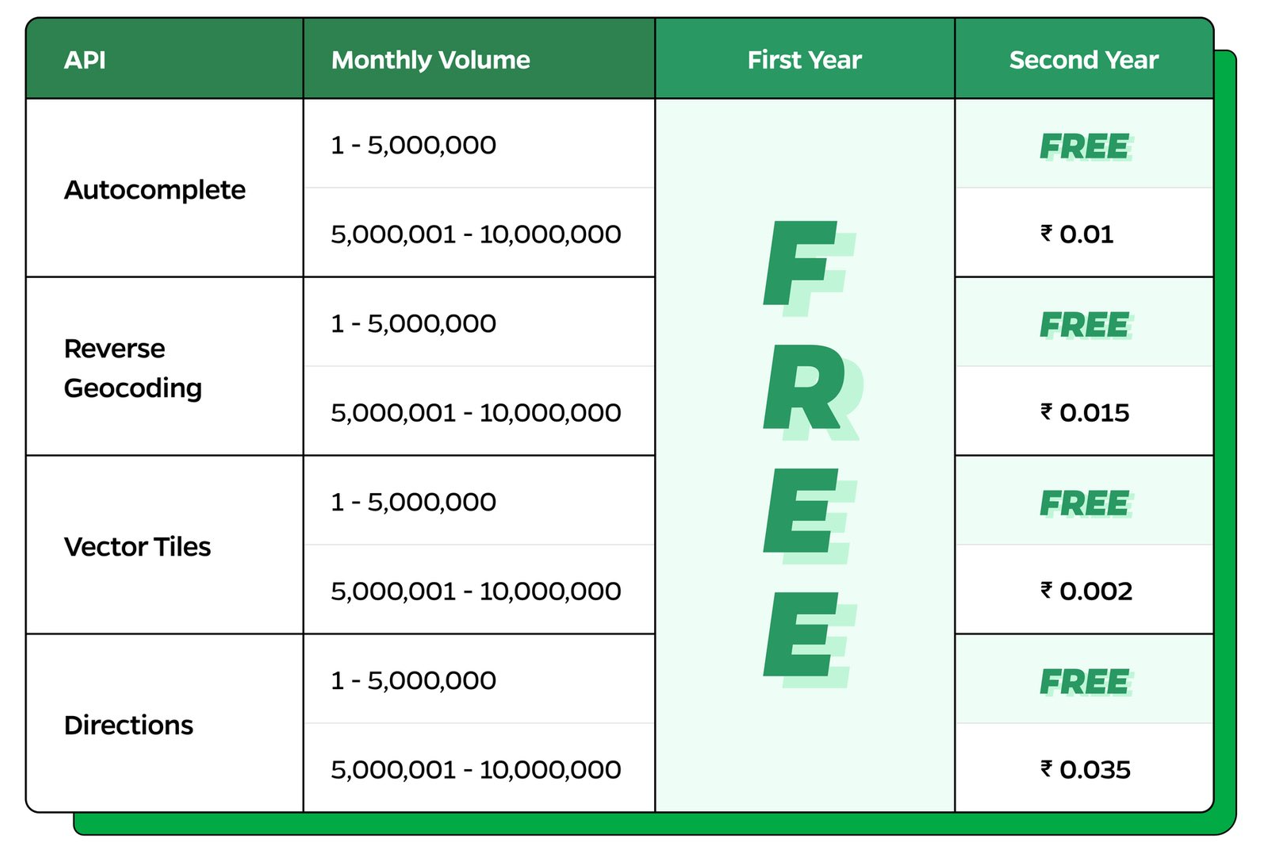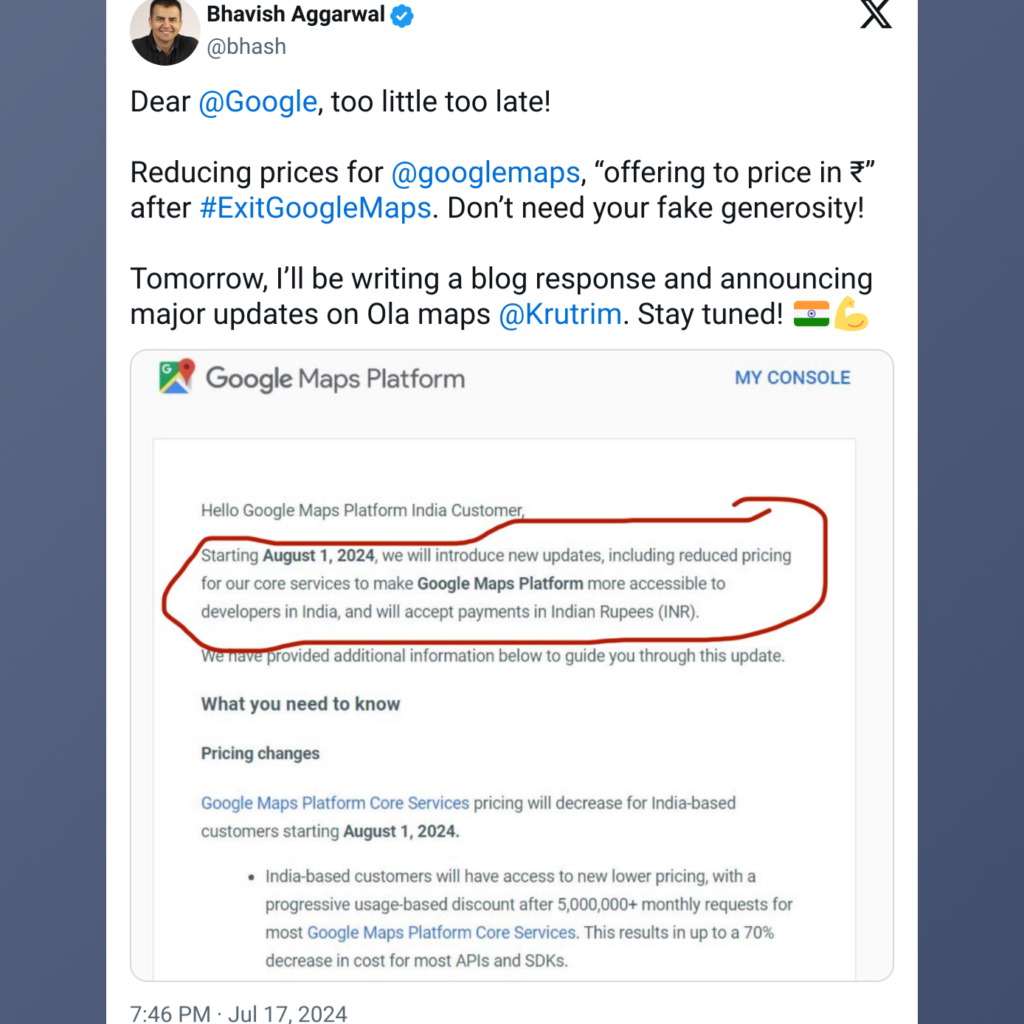In a bold move that’s shaking up India’s digital cartography landscape, Ola Maps has unveiled a groundbreaking pricing structure in response to Google Maps’ recent price cuts. This development marks a significant milestone in the ongoing maps war, showcasing Ola’s commitment to empowering Indian innovation and challenging big tech giants.

For more context, Read our previous blog on this story: Ola Maps Sparks Google Maps Price Drop
Ola Maps’ Revolutionary Pricing Strategy
Bhavish Aggarwal, CEO of Ola, has announced a pricing structure that’s set to disrupt the mapping industry:
- 5 Million Free API Calls: Every month, for all users, covering the needs of most Indian startups.
- Competitive Large Volume Pricing: 50% of Google’s reduced prices for higher usage.
- Long-Term Commitment Bonuses: 2 years free for 3+ year commitments.
- ONDC Support: 3 years free for startups and SMBs on the Open Network for Digital Commerce.

Check out Ola Maps Pricing on their official website: Click here
Breaking Down Ola Maps’ Offer
This aggressive pricing strategy is designed to cater to a wide range of users, from small startups to large enterprises. By offering 5 million free API calls per month, Ola Maps is positioning itself as the go-to solution for India’s burgeoning startup ecosystem.
Ola’s Vision: Beyond Pricing
Bhavish Aggarwal’s announcement goes beyond just pricing. It’s a clarion call for Indian tech companies to step up and create world-class alternatives to global tech giants. This move aligns with India’s push for technological self-reliance and data sovereignty.
Feature Completeness on the Horizon
Ola Maps isn’t just competing on price. Aggarwal has promised feature completeness by December, including:
- Support for all main APIs
- Comprehensive SDKs
- Solutions for niche use cases
This roadmap demonstrates Ola’s commitment to creating a robust, full-featured mapping solution tailored for Indian needs.
The Impact on India’s Tech Ecosystem
Ola Maps’ new pricing and feature roadmap could have far-reaching implications:
- Accelerated Startup Growth: Free API calls could fuel innovation in location-based services.
- Reduced Dependency on Foreign Tech: A homegrown solution reduces reliance on international platforms.
- Data Sovereignty: Keeping mapping data within Indian borders enhances national security.
- Cost Savings for Businesses: Competitive pricing could lead to significant savings for Indian companies.
A Call to Action for Indian Developers
Aggarwal’s statement, “No more following – it’s time to lead!” is a rallying cry for Indian developers and businesses. It encourages them to embrace local solutions and contribute to India’s tech sovereignty.
The Road Ahead for Ola Maps
As Ola Maps continues to evolve, several key questions emerge:
- How will Google respond to this aggressive pricing?
- Can Ola Maps deliver on its promise of feature completeness by December?
- Will other Indian tech companies follow Ola’s lead in challenging global giants?
Changing Dynamics in the Global Tech Scene
- Challenging Global Dominance: Ola Maps’ strategy shows that Indian companies can compete with global tech giants on both features and pricing.
- Attracting Global Attention: This move could draw international investors’ attention to India’s growing tech capabilities.
- Potential for Expansion: If successful in India, Ola Maps could potentially expand to other emerging markets, further challenging Google’s global dominance.
Conclusion: A New Chapter in India’s Tech Story
Ola Maps’ bold pricing strategy and ambitious roadmap mark a significant moment in India’s tech journey. It’s not just about competing with Google Maps; it’s about reimagining what’s possible when Indian companies innovate for Indian needs.
As this maps war unfolds, one thing is clear: the real winners will be Indian businesses and users who now have access to world-class mapping solutions at unprecedented prices. Ola Maps is not just following; it’s leading the charge towards a more self-reliant, innovative India.
External links:
- For more on digital mapping technologies: Overview of Digital Mapping
- To understand the importance of local solutions: India’s Economic Growth and Local Solutions
Thank you for reading the Blog, Click here to check out our other Blogs and Subscribe to our Newsletter.


